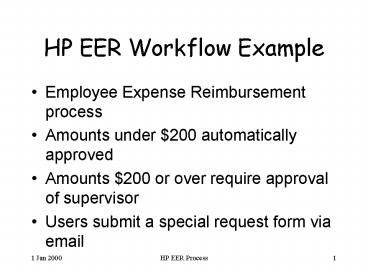HP EER Workflow Example - PowerPoint PPT Presentation
1 / 12
Title:
HP EER Workflow Example
Description:
... states that the submitter should be informed if the process has not completed within 7 days. ... requires that a requisition cannot be open for more than 38 ... – PowerPoint PPT presentation
Number of Views:376
Avg rating:3.0/5.0
Title: HP EER Workflow Example
1
HP EER Workflow Example
- Employee Expense Reimbursement process
- Amounts under 200 automatically approved
- Amounts 200 or over require approval of
supervisor - Users submit a special request form via email
2
Start
HP EER Process Basic Process
ERR Load
Preapproval Decision
Submit for Approval
Approval Decision
Reject
Service Approval
Notify Reject
End
3
HP EER Process Activity Graph Basic Process
Start
Amount lt 200
Amount gt 200
decision Approve
decision Reject
End
4
Adding Business Rules
- Company policy states that the submitter should
be informed if the process has not completed
within 7 days. - Accounting policy requires that a requisition
cannot be open for more than 38 days.
5
Start
HP EER Process Business Rules
ERR Load
No action timer
Notify Approver
Preapproval Decision
Submit for Approval
Notify no action
Approval Decision
Reject
Cancel Transaction Timer
Service Approval
Cancel Service
Notify Reject
End
6
HP EER Process Activity Graph Business Rules
Start
Amount lt 200
Amount gt 200
decision Approve
decision Reject
End
7
Dealing with Exceptions
- The EER process needs to interact with various
existing systems - The corporate personnel database
- The bank transfer system
- Internal accounting system
- The corporate email system
- Normally these system are available, however they
may on occasion be inaccessible
8
Start
HP EER Process Exceptions
ERR Load
ERR Load Re-do Timer
ERR Load error
No action timer
Notify Approver
Preapproval Decision
Submit for Approval
Notify no action
No action Timer
Submit error Timer
Notify error Timer
Check Decision
Approval Decision
Check Notify
Service error Timer
Reject error Timer
Reject
Cancel Transaction Timer
Service Approval
Check Service
Reject error
Cancel Timer
Cancel Service
Check Reject
Service error
Notify Reject
Notify Reject Timer
Check Cancel
Handle Cancel error
Check Notify
End
9
Conclusions and Issues
- Activity States are the correct starting point
for for modeling the definition of the task. The
action state is too primitive. - The entry and exit actions are needed.
- Alternative is to model the definition of process
tasks as a classifier type with associations
representing the transitions. Analogy is product
structure.
10
Conclusions and Issues
- Resource request modeling is not clear.
- Conrad Bock suggests that dependencies can be
used to relate a resource specification to an
activity state. - It appears that Chapter 3.3 Organizational
Definitions from the MDC Business Engineering
Model might cover many of the needs. Expand
beyond people.
11
Conclusions and Issues
- Join/Fork pairing semantics need to be changed.
- Do not require pairing. There are parallel
exception paths for business rules that cannot be
accomplished with a pairing requirement.
12
Conclusions and Issues
- I understand that some changes are proposed for
UML 2.0 in this area, but I have not yet
investigated those. - I do not yet understand the advantages and
disadvantages of a UML profile approach as
proposed by Guus.































